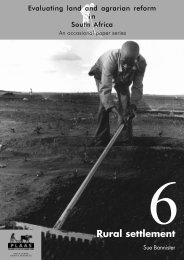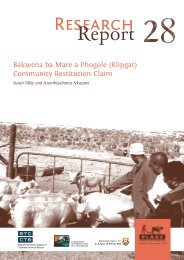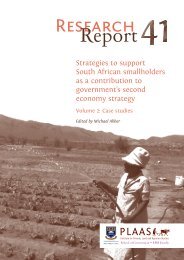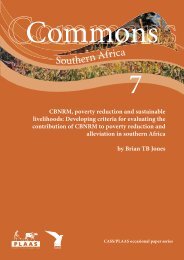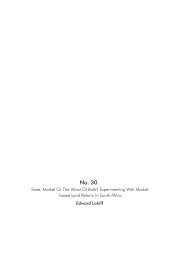A critical appraisal of South Africa's market-based land reform policy
A critical appraisal of South Africa's market-based land reform policy
A critical appraisal of South Africa's market-based land reform policy
Create successful ePaper yourself
Turn your PDF publications into a flip-book with our unique Google optimized e-Paper software.
Chapter 5: The LRAD programme<br />
difficult to hold government accountable<br />
for delivery.<br />
The uncertainty about the target for<br />
<strong>land</strong> redistribution is shared by Limpopo<br />
implementation <strong>of</strong>ficials. The provincial<br />
DLA <strong>of</strong>ficials we interviewed believed the<br />
target for LRAD is to redistribute 30% <strong>of</strong><br />
<strong>land</strong> in 15 years to ‘black, Indian and<br />
coloured’ citizens who are at least 18 years<br />
<strong>of</strong> age. However they were not clear about<br />
whether the 30% refers to all <strong>land</strong>, or only<br />
agricultural <strong>land</strong> (interviews 1, 2 and 3).<br />
The provincial DoA <strong>of</strong>ficial interviewed<br />
noted that LRAD is not the only <strong>land</strong><br />
<strong>reform</strong> programme; implying that 30% is<br />
a target for all forms <strong>of</strong> <strong>land</strong> <strong>reform</strong>, including<br />
restitution (interview 4). DLA staff<br />
have not done any calculation to establish<br />
what the 30% target would mean in terms<br />
<strong>of</strong> hectares <strong>of</strong> <strong>land</strong> to be delivered in<br />
Limpopo, or any estimate <strong>of</strong> how much<br />
<strong>land</strong> they would need to deliver every year<br />
to reach the target, or what any <strong>of</strong> this<br />
would cost.<br />
According to the LRAD <strong>policy</strong> document<br />
(DLA 2001:10) the programme is<br />
intended to assist people to acquire or<br />
lease <strong>land</strong> for agricultural purposes ranging<br />
‘from subsistence to medium-scale<br />
commercial’ operations. However the<br />
<strong>of</strong>ficials we interviewed felt that <strong>land</strong><br />
acquired through LRAD is not for subsistence,<br />
it is strictly for commercial<br />
agricultural purposes.<br />
LRAD beneficiaries must be adults who<br />
were previously disadvantaged in terms <strong>of</strong><br />
race and who want to use the <strong>land</strong> for<br />
agricultural production regardless <strong>of</strong><br />
whether they are rich or poor, although<br />
civil servants are excluded. The LRAD<br />
<strong>policy</strong> document also gives particular<br />
attention to addressing gender imbalances<br />
in access to <strong>land</strong>. In this area LRAD sets a<br />
very clear target: ‘not less than one third <strong>of</strong><br />
the transferred <strong>land</strong> resources must accrue<br />
to women’ (DLA 2001:7). The <strong>of</strong>ficials<br />
interviewed also emphasised that the<br />
<strong>policy</strong> requires the targeting <strong>of</strong> women and<br />
youth (DLA 2001:6–7).<br />
LRAD, as the primary means <strong>of</strong><br />
redistributing <strong>land</strong>, is also expected to<br />
contribute to the overall objectives<br />
contained in the White Paper:<br />
to address the injustices <strong>of</strong><br />
apartheid; to foster national<br />
reconciliation and stability; to<br />
underpin economic growth; and to<br />
improve household welfare and<br />
alleviate poverty (DLA 1997:v).<br />
When assessing the LRAD programme, its<br />
contribution to the achievement <strong>of</strong> these<br />
broader objectives should also be<br />
considered.<br />
LRAD services and support<br />
The primary mechanism <strong>of</strong> LRAD is<br />
grants to beneficiaries. The size <strong>of</strong> a<br />
grant depends on the applicant’s own<br />
contribution, skills and management<br />
ability, although in practice there is no<br />
systematic assessment <strong>of</strong> management<br />
ability (DLA 2001:7; NDA 2001:5). To<br />
receive a R20 000 grant a person must<br />
contribute R5 000. The more a potential<br />
beneficiary can contribute, the larger the<br />
grant he or she qualifies for, up to a<br />
maximum <strong>of</strong> R100 000, for which an own<br />
contribution <strong>of</strong> R400 000 would have be<br />
made (DLA 2001:8–9). The own contribution<br />
may be in the form <strong>of</strong> the beneficiary’s<br />
own labour up to a maximum<br />
value <strong>of</strong> R5 000. Contributions may also<br />
be made in the form <strong>of</strong> cash, assets or<br />
loans. All <strong>of</strong> these may be combined to<br />
make up the full value <strong>of</strong> the contribution<br />
(DLA 2001; NDA 2001). Those applying<br />
as a group have to register a legal entity to<br />
own the <strong>land</strong> and may combine their<br />
grants in order to muster sufficient finance<br />
for the purchase <strong>of</strong> the targeted <strong>land</strong> (NDA<br />
2001:3). DLA also assists beneficiaries to<br />
access loans from the state-owned Land<br />
Bank in order to make up any shortfall for<br />
<strong>land</strong> purchase.<br />
The LRAD <strong>policy</strong> makes provision for<br />
beneficiaries to ‘graduate from smaller to<br />
larger farms’ through receiving further<br />
grants, as long as the total amount <strong>of</strong><br />
grants received by one person never<br />
exceeds the R100 000 maximum. This<br />
facility is intended to enable farmers, who<br />
initially do not have the skills and<br />
19







